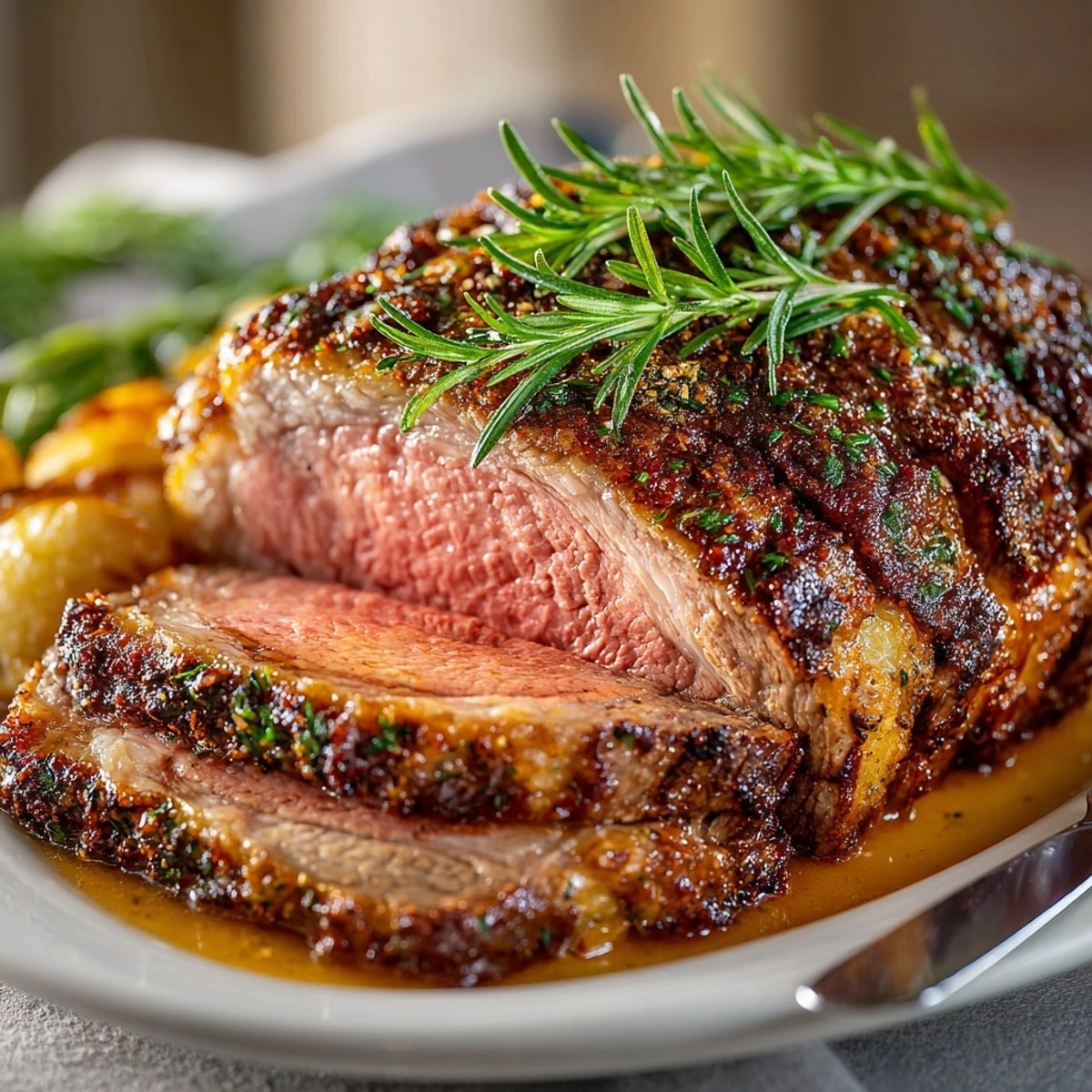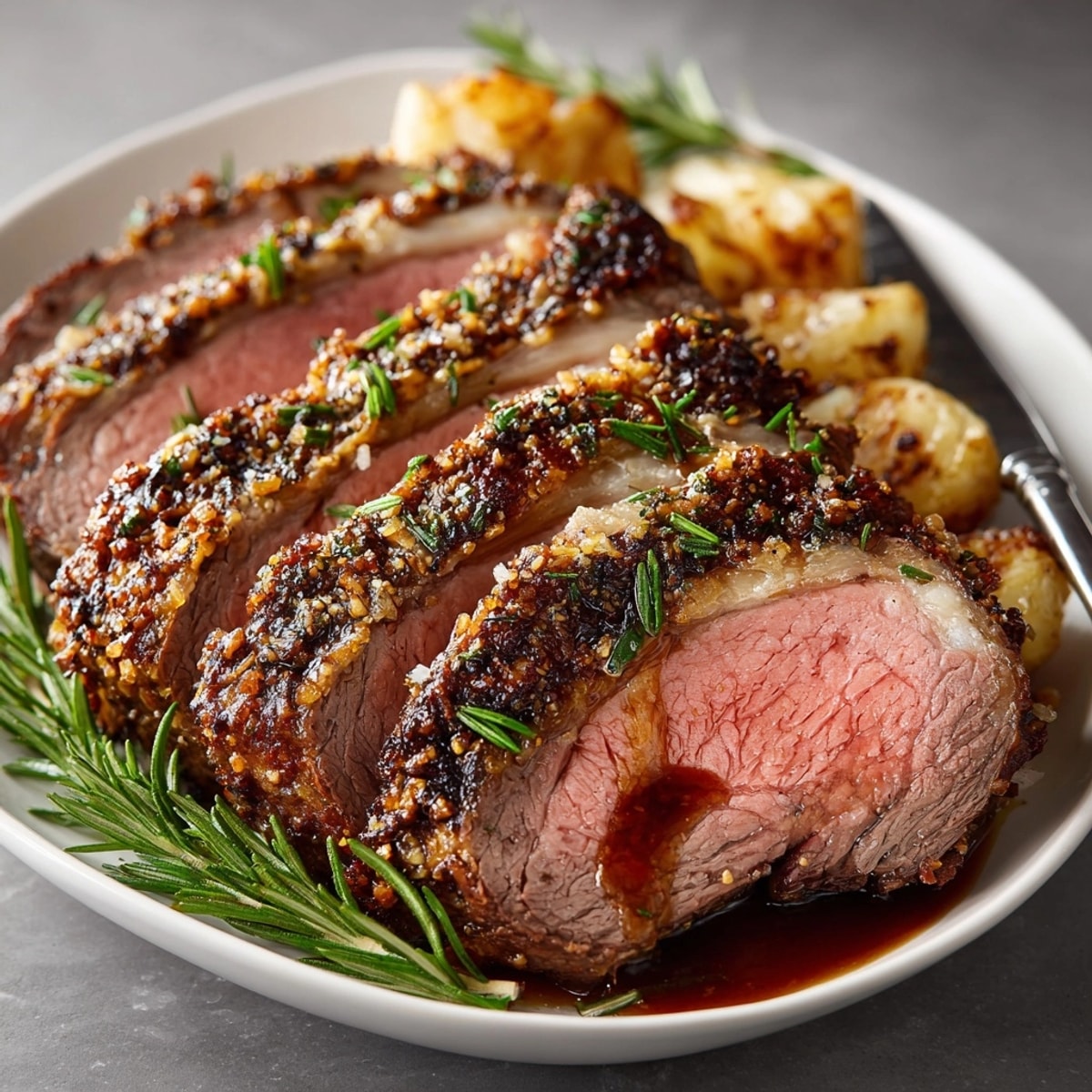 Pin
Pin Roasted garlic and rosemary prime rib is my go-to centerpiece when I want a meal that feels celebratory and comforting all at once Every bite is infused with garlicky savoriness and the deep herbal notes of fresh rosemary making it perfect for holidays or important family dinners
The first time I tried this recipe my family was silent at the table except for the sound of happy savoring It instantly became our most requested holiday main dish and leftovers never last more than a day
Ingredients
- Prime rib: brings succulent tenderness and that classic flavor you want for a special meal Look for a roast with bright red color and good marbling for juiciness
- Garlic: gives a rich mellow sweetness once roasted Choose fresh firm cloves for the most flavor
- Fresh rosemary: delivers bright piney herbaceous notes Always use fresh rosemary for aroma and depth
- Fresh thyme: layers in subtle earthiness adding to the savory roast flavor Use vibrant green sprigs with no wilting
- Olive oil: ensures your herb paste spreads evenly over the meat and helps the crust brown beautifully Pick a robust extra virgin olive oil for best taste
- Kosher salt: seasons deeply and produces that craveable umami crust Go for coarse flakes to help the flavors penetrate
- Freshly ground black pepper: adds gentle heat and complexity Fresh cracked is far better than pre ground
- Low sodium beef broth or red wine: creates a flavor packed au jus for serving Choose wine you would enjoy drinking or use homemade or high quality broth
Instructions
- Let the Roast Come to Temperature:
- Allow the prime rib to sit at room temperature for one hour before cooking This crucial step guarantees more even roasting and a juicier result
- Make the Garlic and Herb Paste:
- Combine peeled garlic, rosemary leaves, thyme leaves, olive oil, salt, and pepper in a food processor Pulse until you achieve a coarse aromatic paste You want everything to be well blended but still see flecks of herbs
- Prep and Season the Roast:
- Pat the prime rib dry with paper towels to help the paste stick well Spread the garlic and herb mixture thoroughly over every surface of the roast Press it in gently so nothing falls off during roasting
- Set Up and Start Roasting:
- Place the seasoned roast bone side down onto a rack set in your roasting pan The rack keeps the meat elevated for even cooking and better crust formation
- Blast with High Heat:
- Roast at 475°F for twenty five minutes This kick starts the browning process so the outside forms a savory crust that locks in juices
- Lower the Heat and Slow Roast:
- Reduce oven temperature to 325°F and continue to cook for one hour and forty five minutes to two hours Monitor closely and check temperature in the thickest part of the meat Aim for 125°F for medium rare perfection
- Rest the Roast:
- Take the roast out and loosely tent with foil Rest at least thirty minutes This makes the juices redistribute so every slice stays tender and moist
- Make the Au Jus:
- Set your roasting pan across two burners on the stove over medium heat Pour in beef broth or wine Scrape up every bit of caramelized flavor from the pan as you simmer for about five to ten minutes Strain the liquid for a delicious jus to drizzle over the meat
- Carve and Serve:
- Slice the roast across the grain into thick juicy slices Arrange on a platter and serve alongside your warm au jus
 Pin
Pin My favorite part of making this dish is mixing the garlic and rosemary paste The aroma fills the kitchen and always brings me back to childhood holidays My family still talks about the year my sister and I tried to outdo each other with our carving skills
Storage Tips
Let the roast cool completely then wrap slices tightly in foil or an airtight container Refrigerate for up to four days or freeze for up to three months Save any leftover jus in a separate jar for reheating
Ingredient Substitutions
No fresh rosemary Use double the amount of dried rosemary Thyme can be swapped for oregano if needed For the jus you can substitute broth with a splash of dry sherry or even just water in a pinch
Serving Suggestions
Prime rib is wonderful with classic sides like creamy mashed potatoes roasted carrots or sautéed greens Do not skip a dollop of tangy horseradish sauce on the side For a festive touch garnish your platter with extra rosemary sprigs
Cultural and Historical Context
Prime rib has American roots as a celebratory cut often served for festive occasions Its popularity grew in the mid twentieth century as a restaurant showpiece and today it remains the epitome of holiday feasting
Seasonal Adaptations
Spring is great for serving with asparagus or fresh peas In winter pair with roasted root vegetables and crusty bread During fall try with a celery root purée or squash for autumnal flavors
 Pin
Pin Let your prime rib be the star of any celebration With these tips and tricks you will serve unforgettable flavor and true comfort every time
Recipe Q&A
- → How do I ensure the prime rib is juicy?
Allow the roast to reach room temperature before cooking and let it rest after roasting to retain juices.
- → Can I use dried herbs instead of fresh?
Fresh herbs deliver optimum flavor, but you can substitute dried ones, using one-third the amount.
- → What is the best doneness for prime rib?
Medium-rare is recommended at 125°F (52°C) internal temperature for a juicy, tender finish.
- → What can I serve with prime rib?
Great pairings include creamy horseradish sauce, roasted vegetables, and a flavorful au jus made from pan drippings.
- → How should I carve prime rib?
Use a sharp carving knife to slice against the grain after the roast has rested at least 30 minutes.
- → Can leftovers be used in other dishes?
Absolutely! Try prime rib sandwiches, wraps, or add slices to salads for maximum flavor.